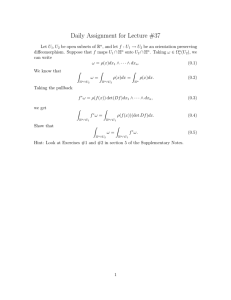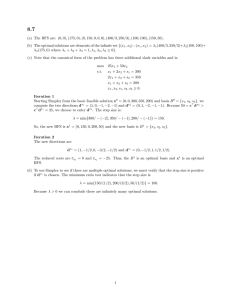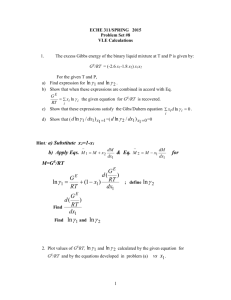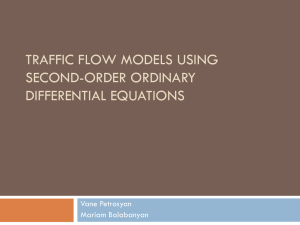Variable and Value Ordering for MPE Search
advertisement
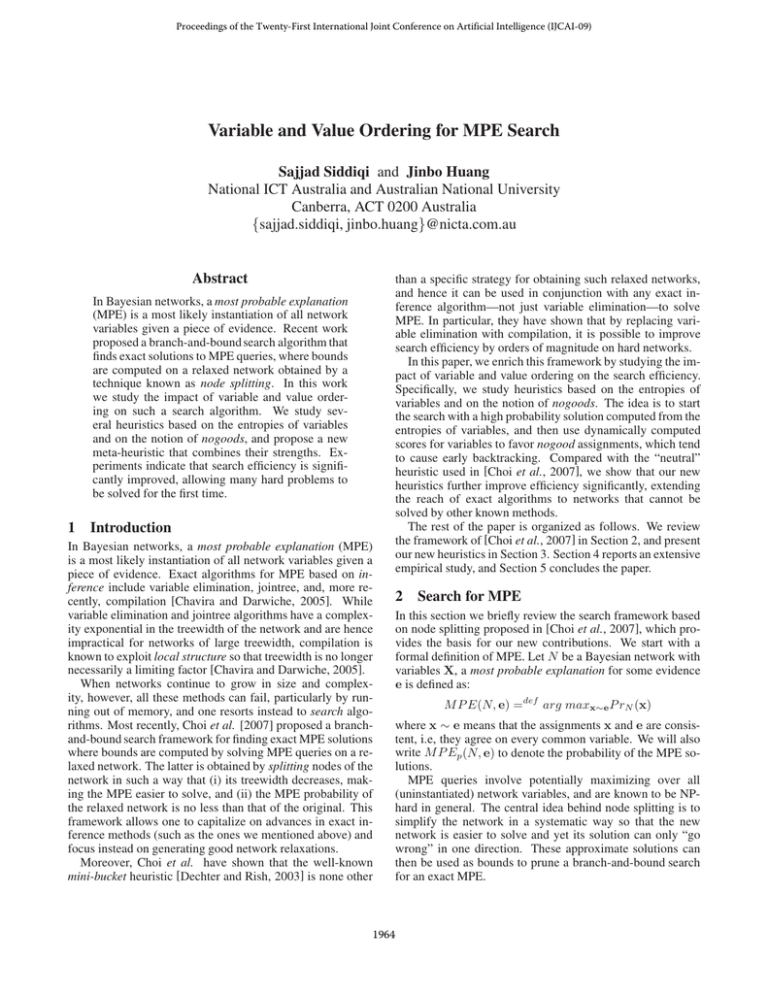
Proceedings of the Twenty-First International Joint Conference on Artificial Intelligence (IJCAI-09)
Variable and Value Ordering for MPE Search
Sajjad Siddiqi and Jinbo Huang
National ICT Australia and Australian National University
Canberra, ACT 0200 Australia
{sajjad.siddiqi, jinbo.huang}@nicta.com.au
Abstract
In Bayesian networks, a most probable explanation
(MPE) is a most likely instantiation of all network
variables given a piece of evidence. Recent work
proposed a branch-and-bound search algorithm that
finds exact solutions to MPE queries, where bounds
are computed on a relaxed network obtained by a
technique known as node splitting. In this work
we study the impact of variable and value ordering on such a search algorithm. We study several heuristics based on the entropies of variables
and on the notion of nogoods, and propose a new
meta-heuristic that combines their strengths. Experiments indicate that search efficiency is significantly improved, allowing many hard problems to
be solved for the first time.
1 Introduction
In Bayesian networks, a most probable explanation (MPE)
is a most likely instantiation of all network variables given a
piece of evidence. Exact algorithms for MPE based on inference include variable elimination, jointree, and, more recently, compilation [Chavira and Darwiche, 2005]. While
variable elimination and jointree algorithms have a complexity exponential in the treewidth of the network and are hence
impractical for networks of large treewidth, compilation is
known to exploit local structure so that treewidth is no longer
necessarily a limiting factor [Chavira and Darwiche, 2005].
When networks continue to grow in size and complexity, however, all these methods can fail, particularly by running out of memory, and one resorts instead to search algorithms. Most recently, Choi et al. [2007] proposed a branchand-bound search framework for finding exact MPE solutions
where bounds are computed by solving MPE queries on a relaxed network. The latter is obtained by splitting nodes of the
network in such a way that (i) its treewidth decreases, making the MPE easier to solve, and (ii) the MPE probability of
the relaxed network is no less than that of the original. This
framework allows one to capitalize on advances in exact inference methods (such as the ones we mentioned above) and
focus instead on generating good network relaxations.
Moreover, Choi et al. have shown that the well-known
mini-bucket heuristic [Dechter and Rish, 2003] is none other
than a specific strategy for obtaining such relaxed networks,
and hence it can be used in conjunction with any exact inference algorithm—not just variable elimination—to solve
MPE. In particular, they have shown that by replacing variable elimination with compilation, it is possible to improve
search efficiency by orders of magnitude on hard networks.
In this paper, we enrich this framework by studying the impact of variable and value ordering on the search efficiency.
Specifically, we study heuristics based on the entropies of
variables and on the notion of nogoods. The idea is to start
the search with a high probability solution computed from the
entropies of variables, and then use dynamically computed
scores for variables to favor nogood assignments, which tend
to cause early backtracking. Compared with the “neutral”
heuristic used in [Choi et al., 2007], we show that our new
heuristics further improve efficiency significantly, extending
the reach of exact algorithms to networks that cannot be
solved by other known methods.
The rest of the paper is organized as follows. We review
the framework of [Choi et al., 2007] in Section 2, and present
our new heuristics in Section 3. Section 4 reports an extensive
empirical study, and Section 5 concludes the paper.
2 Search for MPE
In this section we briefly review the search framework based
on node splitting proposed in [Choi et al., 2007], which provides the basis for our new contributions. We start with a
formal definition of MPE. Let N be a Bayesian network with
variables X, a most probable explanation for some evidence
e is defined as:
M P E(N, e) =def arg maxx∼e P rN (x)
where x ∼ e means that the assignments x and e are consistent, i.e, they agree on every common variable. We will also
write M P Ep (N, e) to denote the probability of the MPE solutions.
MPE queries involve potentially maximizing over all
(uninstantiated) network variables, and are known to be NPhard in general. The central idea behind node splitting is to
simplify the network in a systematic way so that the new
network is easier to solve and yet its solution can only “go
wrong” in one direction. These approximate solutions can
then be used as bounds to prune a branch-and-bound search
for an exact MPE.
1964
Algorithm 1
evidence e
: Computes probability of MPE for
procedure BNB - MPE ( N , e )
inputs: {N : split network}, {e : network instantiation}
global variables: {Y : split variables}, {β : number of possible
assignments to clone variables}
1: bound = βM P E(N , e, e→ )
2: if bound > solution then
3:
if e is complete instantiation of variables Y then
4:
solution = bound
/* bound is exact */
5:
else
6:
pick some X ∈ Y such that X ∈ E
7:
for each value xi of variable X do
8:
e ← e ∪ {X = xi }
BNB - MPE (N , e)
9:
10:
e ← e\{X = xi }
Figure 1: An example of node splitting.
2.1
BNB - MPE
Node Splitting
Node splitting creates a clone X̂ of a node X such that X̂
inherits some of the children of X. Formally:
Definition 1 (Node Splitting). Let X be a node in a Bayesian
network N with children Y. We say that X is split according
to children Z ⊆ Y when it results in a network N that is
obtained from N as follows:
• The edges outgoing from X to its children Z are removed.
• A new root node X̂ with a uniform prior is added to the
network with nodes Z as its children.
A special case of splitting is when X is split according to
every child, in which case X is said to be fully split. Figure 1
shows an example where Y has been split according to both
of its children X and Z, and Ŷ1 , Ŷ2 are clones of Y .
If e is an assignment to variables in network N , we write
e→ to denote the compatible assignment to their clones in N ,
meaning that a variable and its clones (if any) are assigned the
same value. For example, if e = {Y = y}, then e→ = {Ŷ1 =
y, Ŷ2 = y}.
An interesting property of a split network is that the probability of the MPE with respect to the split network gives us
an upper bound on the probability of the MPE with respect to
the original network, after normalization. Formally:
M P Ep (N, e) ≤ βM P Ep (N , e, e→ )
where β is a constant equal to the total number of instantiations of the clone variables. For example, suppose that in
the network of Figure 1a, variables have binary domains and
P r(Y = y) = 0.6, P r(Y = ȳ) = 0.4; all the parameters in
the CPTs of X and Z are 0.5; and e = {Y = ȳ}. Recall that
both Y1 , Y2 are given uniform priors. Then M P Ep (N, e) =
0.10 and M P Ep (N , e, e→ ) = 0.025. The value of β is 4 in
this case and we have M P Ep (N, e) ≤ 4 ∗ 0.025.
In this example the upper bound equals the exact solution.
In general, this is guaranteed if all the split variables have
been instantiated in e (and their clones in e→ ). Hence to
find an exact MPE one need only search in the space of instantiations of the split variables, as opposed to all network
variables. At leaves of the search tree, solutions computed on
the relaxed network give candidate MPE solutions, and elsewhere they give upper bounds to prune the search.
2.2
Branch-and-Bound Search
Algorithm 1 formalizes such a branch-and-bound search (this
code only computes the MPE probability; however the actual
MPE can be recovered with minor book-keeping). The procedure receives a split network N and the evidence e. At each
call to BNB - MPE, the bound βM P E(N , e, e→ ) is computed
(line 1). If the bound becomes less than or equal to the current solution (line 2), meaning that any further advancement
in this part of the search tree is not going to give a better
solution, the search backtracks. Otherwise, if the bound is
greater than the current solution and the current assignment
is complete over split variables, meaning that the bound has
become exact, the current solution is replaced with the better one (lines 3–4). If the assignment is not complete then an
unassigned split variable X is chosen (line 6), e is appended
with the assignment X = xi (line 7), and BNB - MPE is recursively called (line 8). After the recursive call returns the
assignment X = xi is removed from e and other values of X
are tried in the same way.
The choice of which variables to split (variables Y in the
pseudocode) has a fundamental impact on the efficiency of
this approach. More split variables may make the relaxed
network easier to solve, but may loosen the bounds and increase the search space. Choi et al. [2007] studied a strategy
based on jointree construction: A variable is chosen and fully
split that can cause the highest reduction in the size of the
jointree cliques and separators. Once a variable is fully split a
jointree of the new network is constructed, and the process repeated until the treewidth of the network drops to a preset target. This heuristic was shown to outperform the mini-bucket
heuristic in [Choi et al., 2007], and is therefore used in our
present work. Also, given the success reported in [Choi et
al., 2007] we will use compilation as the underlying method
for computing MPEs of relaxed networks.
3 Variable and Value Ordering
As mentioned earlier, by using a neutral heuristic Choi et al.
[2007] has left unaddressed an important aspect of perhaps
any search algorithm—variable and value ordering. Given the
advancements already reported in their work based on combining splitting strategies with new inference methods, one
1965
cannot but wonder whether more sophisticated variable and
value ordering might not take us even farther.
We have thus undertaken this investigation and now take
delight in reporting it here. The first type of heuristic we examined is based on computing the entropies of variables, and
the second on a form of learning from nogoods. We will discuss some of our findings, which have eventually led us to
combine the two heuristics for use in a single algorithm.
3.1
Entropy-based Ordering
We start by reviewing the notion of Shannon’s entropy
ξ [Pearl, 1979], which is defined with respect to a probability distribution of a discrete random variable X ranging over
values x1 , x2 , . . . , xk . Formally:
ξ(X) = −
k
P r(X = xi ) log P r(X = xi ).
i=1
Nogoods
In the constraint satisfaction framework where it was originally studied, a nogood is a partial instantiation of variables
that cannot be extended to a complete solution. In our case,
we define a nogood to be a partial instantiation of the split
variables (i.e., search variables) that results in pruning of the
node (i.e., the upper bound being ≤ the current best candidate
solution).
Note that at the time of pruning, some of the assignments
in the nogood g may contribute more than others to the tightness of the bound (and hence the pruning of the node), and
it may be possible to retract some of those less contributing
assignments from g without loosening the bound enough to
prevent pruning. These refined nogoods can then be learned
(i.e., stored) so that any future search branches containing
them can be immediately pruned.
Nogood learning in this original form comes with the significant overhead of having to re-compute bounds to determine which assignments can be retracted (see the discussion
of Table 1 in Section 4.1). However, it gives us an interesting
motivation for an efficient variable and value ordering heuristic described below.
Entropy quantifies the amount of uncertainty over the value
of the random variable. It is maximal when all probabilities
P r(X = xi ) are equal, and minimal when one of them is 1.
Hence as a first experiment we consider a heuristic that
favors those instantiations of variables that are more likely
to be MPEs. The idea is that finding an MPE earlier helps
terminate the search earlier. To that end, the heuristic prefers
those variables that provide more certainty about their values
(i.e., have smaller entropies), and favor those values of the
chosen variable that are more likely than others (i.e., have
higher probabilities).
This heuristic can be used in either a static or dynamic setting. In a static setting, we order the split variables in increasing order of their entropies, and order the values of each variable in decreasing order of their probabilities, and keep the
order fixed throughout the search. In a dynamic setting, we
update the probabilities of the split variables at each search
node and reorder the variables and values accordingly.
The heuristic requires computing the probabilities of the
values of all split variables, which can be obtained conveniently as we have already assumed that the split network
will be compiled for the purpose of computing its MPE—the
compilation, in the form of arithmetic circuits (ACs), admits
linear-time procedures for obtaining these probabilities. Furthermore, in an attempt to improve the accuracy of the probabilities (with respect to the original network), we take the
average of the probabilities of a split variable and its clones
(for the same value) when evaluating the heuristic.
While we will present detailed results in Section 4, we note
here that our initial experiments clearly showed that a static
entropy-based ordering immediately led to significantly better performance than the neutral heuristic. On the other hand,
the dynamic version, although often effective in reducing the
search tree, turned out to be generally too expensive, resulting
in worse performance overall.
Ordering Heuristic
The idea is to favor those variables and values that can quickly
make the current assignment a nogood, so that backtracking
occurs early during the search. Hence we give scores to the
values of variables proportionate to the amounts of reduction
that their assignments will cause in the bound, and favor those
variables and values that have higher scores.
Specifically, every value xi of a variable X is associated
with a score S(X = xi ), which is initialized to 0. The score
S(X) of the variable X is the average of the scores of its
values. Once a variable X is assigned a value xi , the amount
of reduction in the bound caused by it is added to the score
of X = xi . That is, the score S(X = xi ) is updated as
S(X = xi ) = S(X = xi ) + (cb − nb), where cb is the bound
before assigning the value xi to X and nb is the bound after
the assignment. The heuristic chooses a variable X with the
highest score and assigns values to it in decreasing order of
the scores of those values.
During initial experiments we observed that over the
course of the search the scores can become misleading, as
past updates to the scores may have lost their relevance under
the current search conditions. To counter this effect, we reinitialize the scores periodically, and have found empirically that
a period of 2000 search nodes tends to work well.
Finally, we combine this heuristic with the entropy-based
approach by using the entropy-based static order as the initial
order of the variables and their values, so that the search may
tend to start with a better candidate solution. We now proceed to present an empirical study which shows, among other
things, that this combined heuristic gives significantly better
performance both in terms of search space and time.
3.2
4 Experimental Results
Nogood-based Ordering
Hence we need to look further if we desire an effective heuristic that remains inexpensive in a dynamic setting. Here the
notion of learning from nogoods comes to rescue.
In this empirical study we evaluate the different heuristics we
have proposed, and in particular show that with the final combined heuristic we achieve significant advances in efficiency
1966
Figure 2: Comparing search spaces on grid networks.
Figure 3: Comparing search times on grid networks.
and scalability, able to solve problems that are intractable for
other known methods.
We conducted our experiments on a cluster of computers
consisting of two types of (comparable) CPUs, Intel Core
Duo 2.4 GHz and AMD Athlon 64 X2 Dual Core Processor
4600+, both with 4 GB of RAM running Linux. A memory
limit of 1 GB was imposed on each test case. Compilation of
Bayesian networks was done using the C 2 D compiler [Darwiche, 2004; 2005]. We use a trivial seed of 0 as the initial
MPE solution to start the search. In general, we keep splitting
the network variables until treewidth becomes ≤ 10, unless
otherwise stated.
We used a variety of networks: the grid networks introduced in [Sang et al., 2005], a set of randomly generated networks as in [Marinescu et al., 2003], networks for genetic
linkage analysis, and a set of 42 networks for decoding errorcorrecting codes as generated in [Choi et al., 2007]. The last
group were trivial to solve by all the three heuristics, so we
do not report results for them.
For each heuristic, we report the number of cases solved,
search time, and search space, where the search space are
time are averages over solved cases. We also compare the
performance of heuristics on those cases that were solved by
all heuristics. As a reference point, we generated a random
static variable and value order for the split variables in each
split network instance and compared all the heuristics against
it. The comparison showed that the new heuristics generally
provide many orders of magnitude savings in search time and
space over the random heuristic, and hence we will only include the new heuristics in the presented results. Finally, we
will write SVO and DVO as shorthand for static and dynamic
variable and value ordering, respectively.
the scores after the specified period. However, the scores are
updated as follows: When a nogood is learned, the score is
incremented for each literal in the nogood. We compare the
performance of both techniques by computing the MPE for
the empty evidence on each network. For NG - DVO we also
report the average number of nogoods learned and the average number of branches pruned by nogoods. The results
clearly show that score-based DVO is significantly faster than
nogood learning and results in a much reduced search space.
We then show that the score-based DVO performs consistently better than other heuristics when the number of splits
in a network is varied. For this purpose, we consider only 80
instances of these networks, in the range 90-20-1 to 90-309, which are some of the harder instances in this suite. The
treewidths of these instances range from high twenties up to
low forties. However, all of them can be compiled with a
single split using the strategy mentioned above.
For each instance we split the network using 1 up to 50
splits, making a total of 50 ∗ 80 = 4000 cases to solve. For
each case we compute the MPE for the empty evidence under
a time limit of 15 minutes. The entropy-based DVO solved
3656 cases, entropy-based SVO solved 3968 cases, and scorebased DVO solved 3980 cases, where the score-based DVO
solved all those cases solved by the others. We plot a graph
of search space against the number of splits, and a graph of
search time against the number of splits. Each of data point
on the graphs is the average of search spaces/time for those
queries solved by all three heuristics.
In Figure 2, we observe that, interestingly, entropy-based
SVO can often perform significantly better than entropy-based
DVO , although its search space starts to grow faster than the
DVO when the number of splits increases. This can be ascribed to the fact that DVO can exploit the changing probabilities of variables during search. The most significant result,
however, is that for any number of splits the search space of
score-based DVO is generally much smaller than that of the
other two, and becomes orders of magnitude smaller when
the number of splits grows.
In Figure 3, we observe that entropy-based DVO gives poor
performance, apparently because it has to do expensive prob-
4.1
Grid Networks
We first use these networks to show, in Table 1, that the scorebased dynamic ordering (referred to as SC - DVO) outperforms
nogood learning itself. For this purpose, we consider a similar dynamic ordering referred to as NG - DVO in the table.
This heuristic starts with the same initial order, uses the same
method of variable and value selection, and also reinitializes
1967
cases solved
NG - DVO
networks cases
Ratio 50 90
Ratio 75 150
Ratio 90 210
SC - DVO
common cases
SC - DVO
time space time space
89.5 2337 7.7 1218
74.8 3202 3.4 1648
42.3 6161 1.6 1402
NG - DVO
solved time space nogoods pruned solved time space
77 89.5 2337 875
576
90 33.2 3365
108 74.8 3202 1019 1159 139 49.7 14875
135 42.3 6161 873 4413 160 26.2 13719
Table 1: Comparing nogood learning with score-based DVO on grid networks.
cases solved
common cases
ENT- SVO
SC - DVO
ENT- DVO
ENT- SVO
SC - DVO
solved time space solved time space solved time space time space time space time space
2250 1890 95.7 6286 2121 51.6 8262 2248 25.9 2616 94.1 6215 24.3 4619 7.3 1082
3750 2693 60.3 5195 3015 40.4 15547 3624 38.0 10909 57.2 4965 15.3 6722 1.6 712
5250 3463 23.4 2387 3599 22.2 12919 3995 8.2 4453 20.0 2102 10.0 6740 0.3 275
networks cases
Ratio 50
Ratio 75
Ratio 90
ENT- DVO
Table 2: Results on grid networks.
ability updates at each search node. Again, we note that the
score-based DVO is generally much faster than the other two
heurstics, and becomes orders of magnitude faster when the
number of splits grows.
To further assess the performance of heuristics on a wide
range of MPE queries, we considered the whole suite of grid
networks and randomly generated 25 queries for each network. The results, summarized in Table 2, again confirm that
the performance of entropy-based DVO is significantly better
than that of the other two heuristics.
4.2
pedigree13
pedigree19
pedigree31
pedigree34
pedigree40
pedigree41
pedigree44
pedigree51
Networks for Genetic Linkage Analaysis
We now consider even harder cases from genetic linkage
analysis (http://bioinfo.cs.technion.a.c.il/superlink/). We extracted 8 networks that have high treewidths and cannot be
compiled without splitting, and considered 20 randomly generated MPE queries on each of them, for a total of 160
treewidth splits solved
43
83
20
36
59
12
44
84
16
35
79
12
37
72
2
43
84
9
33
54
5
54
75
16
SC - DVO
time
1728
6868
6672
5109
6575
7517
7041
3451
space
168251
532717
446583
332899
745088
783737
673165
268774
Table 4: Results on networks for genetic linkage analysis.
Randomly Generated Networks
Next, to evaluate the scalability of the heuristics we tried them
on a number of randomly generated networks of increasing
size and treewidth, according to the model of [Marinescu et
al., 2003]. Networks are generated according to the parameters (N, K, C, P ), where N is the number of variables, K
is their domain size, C is the number of CPTs, and P is
the number of parents in each CPT. The network structure
is created by randomly picking C variables out of N and,
for each, randomly selecting P parents from the preceding
variables, relative to some ordering. Each CPT is generated
uniformly at random. We used C = 90%N , P = 2, K = 3,
and N ranging from 100 to 200 at increments of 10. The
treewidths of these networks range from 15 to 33, and generally increases with N . For each network size we generated 20
network instances, and for each instance generated a random
MPE query, making a total of 20 queries per network size.
The time limit to solve each query was set to 1 hour.
The results of these experiments are summarized in Table 3. The score-based DVO solved all those cases that the
other two could solve, plus more, and scales much better
when the network size increases. On cases solved by all three,
the performance of score-based DVO is also the best in terms
of both search time and space.
4.3
network
cases solved
time on common cases
SC - DVO
networks cases SamIam
solved time solved time SamIam SC - DVO
Ratio 50 90
49 23.8 90 31.1
23.8
1.4
Ratio 75 150
45 14.1 148 185.4 14.1
0.3
Ratio 90 210
48 18.9 169 114.5 18.9
0.1
Table 5: Comparison with SamIam on grid networks.
queries. Since these networks are significantly harder, the
time limit on each query was set to 4 hours.
The results on these networks are summarized in Table 4.
We report the estimated treewidths of the networks and the
number of splits performed on each of them, and only show
results for score-based DVO, as the two entropy-based heuristics could only solve 9 trivial cases when the MPE for the
given evidence was already 0 and the search was not performed at all. The score-based DVO, by contrast, solved most
of the cases, which further establishes its better scalability.
4.4
Comparison with Other Tools
First we compare our MPE solver SC - DVO with an independent Bayesian network inference engine known as SamIam
(http://reasoning.cs.ucla.edu/samiam/). As we were unable to
run SamIam on our cluster, these experiments were conducted
on a machine with a 3.2 GHz Intel Pentium IV processor and
2 GB of RAM running Linux. For each network we compute
the MPE for the empty evidence under a time limit of 1 hour.
The random and genetic linkage analysis networks proved
too hard to be solved by SamIam. For the grid networks, the
results of the comparison are summarized in Table 5. We
observe that SC - DVO solved roughly from 2 to 3 times more
1968
cases solved
common cases
ENT- SVO
SC - DVO
ENT- DVO
ENT- SVO
solved time space solved time space solved time space time space time space
100
20
131 867
20
47
696
20
31
532
131 867
47
696
110
20
187 1800
20
70 1270
20
67
952
187 1800
70 1270
120
19
923 9374
20
471 7760
20
210 3061 923 9374 434 7640
130
12 1100 10849
15 1100 19755
18
561 7462 1100 10849 729 11168
140
7
1715 19621
11 1340 28574
15 1090 10545 1680 20016 741 17965
150
1
2505 10800
6
1859 41628
15 1619 25293 2505 10800 809 8727
160
0
n.a. n.a.
1
2379 22428
6
2257 36884 n.a. n.a.
n.a. n.a.
170
2
0.1
0
2
0.1
0
3
637 14319 n.a. n.a.
n.a. n.a.
ENT- DVO
size
SC - DVO
time
31
67
188
291
311
634
n.a.
n.a.
space
532
952
2950
3989
4529
6789
n.a.
n.a.
Table 3: Results on random networks.
networks cases
Ratio 50
Ratio 75
Ratio 90
9
15
15
cases solved
time on common cases
SC - DVO
SC - DVO
solved time solved time SMBBF
7
5.39
9
14.33 5.39
4.34
10 16.16 15 199.11 16.16
2.1
10 7.32 15
3.87
7.32
0.429
SMBBF
Table 6: Comparison with SMBBF on grid networks.
ation indicates that significant improvements in search time
and space are achieved over less sophisticated heuristics and
over existing MPE solvers. On the whole, we have extended
the reach of exact MPE algorithms to many hard networks
that are now solved for the first time.
Acknowledgments
instances than SamIam, and on cases solved by both our solve
is also orders of magnitude faster.
We then compare SC - DVO with the best-first search algorithm (SMBBF) of [Marinescu and Dechter, 2007]. This tool
is only available for Windows, and we used a machine with
an Intel Core 2 Duo 2.33 GHz and 1 GB of memory running
Windows. Note that our solver SC - DVO was run on a cluster with comparable CPU speeds. However, since Windows
reserves some of the memory for the operating system, we accordingly reduced the memory limit for SC - DVO from 1 GB
to 768 MB for these experiments. Again a time limit of 1
hour was imposed for each query, computing the MPE for the
empty evidence .
SMBBF requires a parameter i that bounds the mini-bucket
size. The results of [Marinescu and Dechter, 2007] do not appear to suggest any preferred value for i; hence we somewhat
arbitrality set i = 20 taking into account the relatively high
treewidth of our benchmarks.
Due to limited computational resources we used a sample
of the grid networks under each ratio category such that each
selected network represented a class of networks comparable
in difficulty. The comparison of is shown in Table 6. In contrast to SC - DVO, SMBBF failed to solve a significant number
of the networks; it was also slower on the networks that were
solved by both.
Finally, from the random networks we arbitrarily took 4
networks of size 100, 110, 120, and 130, respectively, and
from the networks for genetic linkage analysis we took pedigree13, the apparently easiest one. None of these instances
could be solved by SMBBF, which quicky ran out of memory and got terminated by the operating system. By contrast,
SC - DVO solved all of them.
5 Conclusion
We have presented a novel and efficient heuristic for dynamically ordering variables and their values in a branch-andbound search for MPE. A comprehensive empirical evalu-
Thanks to the anonymous reviewers for their comments. National ICT Australia is funded by the Australian Government’s Backing Australia’s Ability initiative, in part through
the Australian Research Council.
References
[Chavira and Darwiche, 2005] Mark Chavira and Adnan Darwiche.
Compiling bayesian networks with local structure. In Proceedings of the 19th International Joint Conference on Artificial Intelligence (IJCAI), pages 1306–1312, 2005.
[Choi et al., 2007] Arthur Choi, Mark Chavira, and Adnan Darwiche. Node splitting: A scheme for generating upper bounds
in bayesian networks. In Proceedings of the 23rd Conference on
Uncertainty in Artificial Intelligence (UAI), pages 57–66, 2007.
[Darwiche, 2004] Adnan Darwiche. New advances in compiling
CNF into decomposable negation normal form. In Proceedings of
the 16th European Conference on Artificial Intelligence (ECAI),
pages 328–332, 2004.
[Darwiche, 2005] Adnan Darwiche. The C 2 D compiler user manual. Technical Report D-147, Computer Science Department,
UCLA, 2005. http://reasoning.cs.ucla.edu/c2d/.
[Dechter and Rish, 2003] Rina Dechter and Irina Rish. Minibuckets: A general scheme for bounded inference. Journal of
the ACM, 50(2):107–153, 2003.
[Marinescu and Dechter, 2007] Radu Marinescu and Rina Dechter.
Best-first AND/OR search for most probable explanations. In
Proceedings of the 23rd Conference on Uncertainty in Artificial
Intelligence (UAI), 2007.
[Marinescu et al., 2003] Radu Marinescu, Kalev Kask, and Rina
Dechter. Systematic vs. non-systematic algorithms for solving
the MPE task. In Proceedings of the 19th Conference on Uncertainty in Artificial Intelligence (UAI), 2003.
[Pearl, 1979] Judea Pearl. Entropy, information and rational decisions. Policy Analysis and Information Systems, Special Issue on
Mathematical Foundations, 3(1):93–109, 1979.
[Sang et al., 2005] Tian Sang, Paul Beame, and Henry Kautz. Solving bayesian networks by weighted model counting. In Proceedings of the 20th National Conference on Artificial Intelligence
(AAAI), volume 1, pages 475–482. AAAI Press, 2005.
1969
